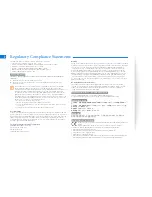
53
Advanced
Features
Use this function for shots to get the correct brightness (exposure), such as shots with extremely
high contrast between the subject and the background.
Set the Power switch to “
q
”.
1
Set the Mode dial to “
N
”, “
M
” or “
<
” mode.
2
250
250 F5.6
33
33
P
ISO
ISO 200
200
1
Hold down “
D
” button.
2
Turn the Command dial to set the compensation value.
The symbol indicating the compensation direction
(“–” or “+”) turns yellow. The “
D
” icon also turns
yellow while exposure compensation is being set
and then turns blue after setting is completed.
h
Compensation range
–2 EV to +2 EV (13 steps in 1/3 EV increments)
●
!
Exposure compensation cannot be used in the “
B
”, “
?
”
and “
>
” modes.
●
!
Exposure compensation is disabled in the following
situations:
When “
d
” (Forced flash) or “
b
” (Red-eye reduction) mode is
used and the scene is dark.
0
1
0
2
3
Exposure
compensation
indicator
This setting is retained when the mode is changed
or the camera is turned off ( “
D
” appears). Set the
exposure compensation to “0” unless compensation
is required.
D
EXPOSURE COMPENSATION
STILL PHOTOGRAPHY FUNCTIONS
◆
To obtain the optimum brightness
◆
Adjust the exposure compensation according to the level of brightness or darkness in the image.
■
Guide to compensation
i
Backlit portraits: +2 steps to +4 steps (+0.7 EV to +1.3 EV)
i
Very bright scenes (such as snowfields) and highly reflective subjects: +3 steps (+1 EV)
i
Shots made up predominantly of sky: +3 steps (+1 EV)
i
Spotlit subjects, particularly against dark backgrounds: –2 steps (–0.7 EV)
i
Scenes with low reflectivity, such as shots of pine trees or dark foliage: –2 steps (–0.7 EV)
h
When the subject appears too bright
Try a negative (–) compensation setting.
This will make the overall image darker.
h
When the subject appears too dark
Try a positive (+) compensation setting.
This will make the overall image brighter.
















































